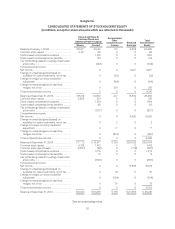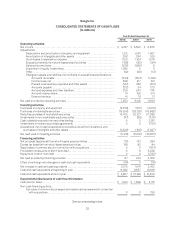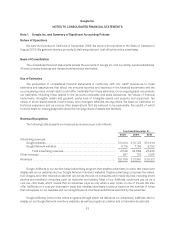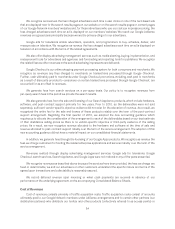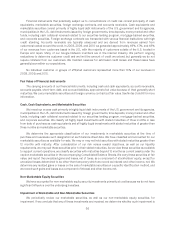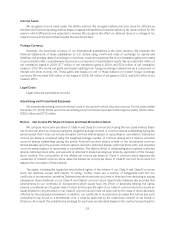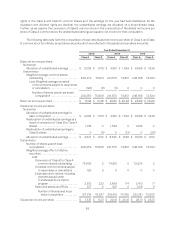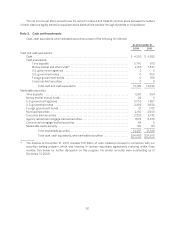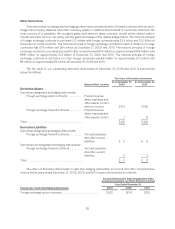Google 2010 Annual Report Download - page 69
Download and view the complete annual report
Please find page 69 of the 2010 Google annual report below. You can navigate through the pages in the report by either clicking on the pages listed below, or by using the keyword search tool below to find specific information within the annual report.Financial instruments that potentially subject us to concentrations of credit risk consist principally of cash
equivalents, marketable securities, foreign exchange contracts, and accounts receivable. Cash equivalents and
marketable securities consist primarily of highly liquid debt instruments of the U.S. government and its agencies,
municipalities in the U.S., debt instruments issued by foreign governments, time deposits, money market and other
funds, including cash collateral received related to our securities lending program, mortgage-backed securities,
and corporate securities. Foreign exchange contracts are transacted with various financial institutions with high
credit standing. Accounts receivable are typically unsecured and are derived from revenues earned from
customers located around the world. In 2008, 2009, and 2010 we generated approximately 49%, 47%, and 48%
of our revenues from customers based in the U.S., with the majority of customers outside of the U.S. located in
Europe and Japan. Many of our Google Network members are in the internet industry. We perform ongoing
evaluations to determine customer credit and we limit the amount of credit we extend, but generally we do not
require collateral from our customers. We maintain reserves for estimated credit losses and these losses have
generally been within our expectations.
No individual customer or groups of affiliated customers represented more than 10% of our revenues in
2008, 2009, and 2010.
Fair Value of Financial Instruments
The carrying amounts of our financial instruments, including cash and cash equivalents, accounts receivable,
accounts payable, short-term debt, and accrued liabilities, approximate fair value because of their generally short
maturities. We carry marketable securities and foreign currency contracts at fair value. See Notes 3 and 6 for more
information.
Cash, Cash Equivalents, and Marketable Securities
We invest our excess cash primarily in highly liquid debt instruments of the U.S. government and its agencies,
municipalities in the U.S., debt instruments issued by foreign governments, time deposits, money market and other
funds, including cash collateral received related to our securities lending program, mortgage-backed securities,
and corporate securities. We classify all highly liquid investments with stated maturities of three months or less
from date of purchase as cash equivalents and all highly liquid investments with stated maturities of greater than
three months as marketable securities.
We determine the appropriate classification of our investments in marketable securities at the time of
purchase and reevaluate such designation at each balance sheet date. We have classified and accounted for our
marketable securities as available-for-sale. We may or may not hold securities with stated maturities greater than
12 months until maturity. After consideration of our risk versus reward objectives, as well as our liquidity
requirements, we may sell these securities prior to their stated maturities. As we view these securities as available
to support current operations, we classify securities with maturities beyond 12 months as current assets under the
caption marketable securities in the accompanying Consolidated Balance Sheets. We carry these securities at fair
value, and report the unrealized gains and losses, net of taxes, as a component of stockholders’ equity, except for
unrealized losses determined to be other-than-temporary which we record as interest and other income, net. We
determine any realized gains or losses on the sale of marketable securities on a specific identification method, and
we record such gains and losses as a component of interest and other income, net.
Non-Marketable Equity Securities
We have accounted for non-marketable equity security investments primarily at cost because we do not have
significant influence over the underlying investees.
Impairment of Marketable and Non-Marketable Securities
We periodically review our marketable securities, as well as our non-marketable equity securities, for
impairment. If we conclude that any of these investments are impaired, we determine whether such impairment is
56







